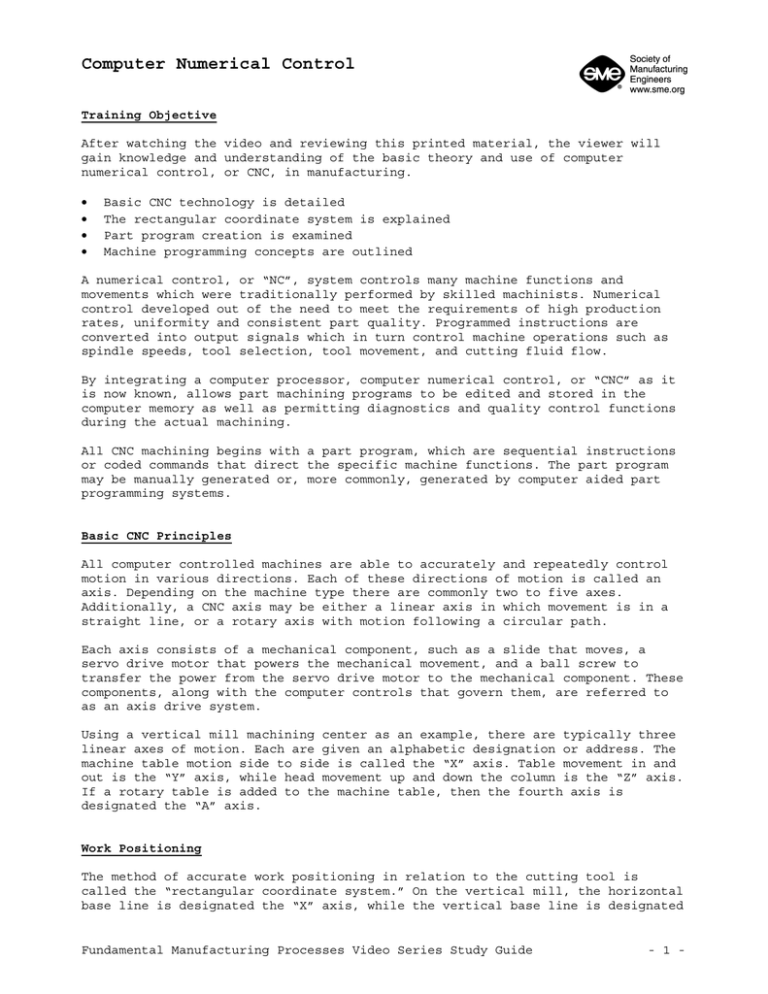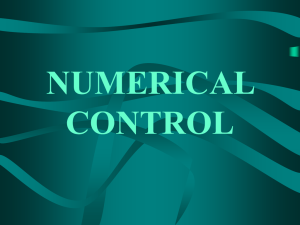Computer Numerical Control
advertisement

Computer Numerical Control Training Objective After watching the video and reviewing this printed material, the viewer will gain knowledge and understanding of the basic theory and use of computer numerical control, or CNC, in manufacturing. • • • • Basic CNC technology is detailed The rectangular coordinate system is explained Part program creation is examined Machine programming concepts are outlined A numerical control, or “NC”, system controls many machine functions and movements which were traditionally performed by skilled machinists. Numerical control developed out of the need to meet the requirements of high production rates, uniformity and consistent part quality. Programmed instructions are converted into output signals which in turn control machine operations such as spindle speeds, tool selection, tool movement, and cutting fluid flow. By integrating a computer processor, computer numerical control, or “CNC” as it is now known, allows part machining programs to be edited and stored in the computer memory as well as permitting diagnostics and quality control functions during the actual machining. All CNC machining begins with a part program, which are sequential instructions or coded commands that direct the specific machine functions. The part program may be manually generated or, more commonly, generated by computer aided part programming systems. Basic CNC Principles All computer controlled machines are able to accurately and repeatedly control motion in various directions. Each of these directions of motion is called an axis. Depending on the machine type there are commonly two to five axes. Additionally, a CNC axis may be either a linear axis in which movement is in a straight line, or a rotary axis with motion following a circular path. Each axis consists of a mechanical component, such as a slide that moves, a servo drive motor that powers the mechanical movement, and a ball screw to transfer the power from the servo drive motor to the mechanical component. These components, along with the computer controls that govern them, are referred to as an axis drive system. Using a vertical mill machining center as an example, there are typically three linear axes of motion. Each are given an alphabetic designation or address. The machine table motion side to side is called the “X” axis. Table movement in and out is the “Y” axis, while head movement up and down the column is the “Z” axis. If a rotary table is added to the machine table, then the fourth axis is designated the “A” axis. Work Positioning The method of accurate work positioning in relation to the cutting tool is called the “rectangular coordinate system.” On the vertical mill, the horizontal base line is designated the “X” axis, while the vertical base line is designated Fundamental Manufacturing Processes Video Series Study Guide - 1 - Computer Numerical Control the “Y” axis. The “Z” axis is at a right angle, perpendicular to both the “X” and “Y” axes. Increments for all base lines are specified in linear measurements, for most machines the smallest increment is one ten-thousandth of an inch (.0001). If the machine is graduated in metric the smallest increment is usually one thousandth of a millimeter (.001mm). The rectangular coordinate system allows the mathematical plotting of points in space. These points or locations are called “coordinates.” The coordinates in turn relate to the tool center and dictate the “tool path” through the work. The location where the rectangular coordinate base lines intersect is known as “program zero,” “work zero,” “part zero,” or “part origin.” This location is the point from which all other coordinates are derived. The placement of program zero can vary from part to part. The two modes of specifying coordinates are the “absolute mode” and the “incremental mode.” In the absolute mode all coordinates are referenced from program zero and may carry plus or minus values (polarity). Additionally, in the absolute mode, the rectangular coordinate system is segmented into four quadrants to help establish a coordinate’s polarity. Each “incremental” coordinate is referenced from each of the previously located coordinate. The absolute mode is the most often used in CNC programming. CNC Programming Basics CNC instructions are called part program commands. When running, a part program is interpreted one command line at a time until all lines are completed. Commands, which are also referred to as blocks, are made up of words which each begin with a letter address and end with a numerical value. Each letter address relates to a specific machine function. “G” and “M” letter addresses are two of the most common. A “G” letter specifies certain machine preparations such as inch or metric modes, or absolutes versus incremental modes. A “M” letter specifies miscellaneous machine functions and work like onoff switches for coolant flow, tool changing, or spindle rotation. Other letter addresses are used to direct a wide variety of other machine commands. Program Command Parameters Optimum machine programming requires consideration of certain machine operating parameters including: • • • Positioning control Compensations Special machine features Positioning control is the ability to program tool and machine slide movement simultaneously along two or more axes. Positioning may be for point-to-point movement or for contouring movement along a continuous path. Contouring requires tool movement along multiple axes simultaneously. This movement is referred to as “Interpolation” which is the process of calculating intermediate values between specific points along a programmed path and outputting those values as a precise motion. Interpolation may be linear having just a start and end point Fundamental Manufacturing Processes Video Series Study Guide - 2 - Computer Numerical Control along a straight line, or circular which requires an end point, a center and a direction around the arc. Compensations address tooling related variations. Two of the most important types are tool length compensation and cutter radius compensation. Special features are those which can minimize CNC programming errors. A common special feature is a canned cycle which allows many different instructions to be programmed into just a single command. Hole making and associated secondary operations are made with canned cycles. CAD/CAM Two computer-based systems which impact the use of CNC technology are computer aided design and computer aided manufacturing. A computer aided design, or CAD, system uses computers to graphically create product designs and models. These designs can be reviewed, revised, and refined for optimum end use and application. Once finalized, the CAD design is then exported to a computer aided manufacturing, or CAM, system. CAM systems assist in all phases of manufacturing a product, including process planning, production planning, machining, scheduling, management and quality control. Fundamental Manufacturing Processes Video Series Study Guide - 3 - Computer Numerical Control Review Questions 1. A part program is a: a. layout design b. isometric part rendition c. set of sequential machine instructions d. tool path wireframe display 2. A directional movement of a machine component is referred to as a: a. surge b. slide c. servo d. axis 3. The number of machine axes may be: a. 2 to 5 b. 5 to 7 c. an infinite number d. 1 to 3 4. Vertical milling machine table movement in and out is the: a. “Z” axis b. “A” axis c. “Y” axis d. “X” axis 5. A coordinate is a: a. series of program instructions b. mathematical location c. computer generated point in space d. complete CNC system 6. In a. b. c. d. 7. Each specific machine function has a: a. ID code b. coordinate point c. axis designate d. letter address 8. When programming, a “compensation” usually relates to: a. tooling variations b. spindle speed c. table movement d. number of machine axes 9. A “canned” cycle is one that: a. can minimize program errors b. can contain multiple instructions c. is repeatable using a single command d. all of the above the absolute mode all references begin: at program zero from the last previous coordinate point at the first programmed coordinate point from the “X” axis baseline Fundamental Manufacturing Processes Video Series Study Guide - 4 - Computer Numerical Control Answer Key 1. 2. 3. 4. 5. 6. 7. 8. 9. c d a c b a d a d Fundamental Manufacturing Processes Video Series Study Guide - 5 -






